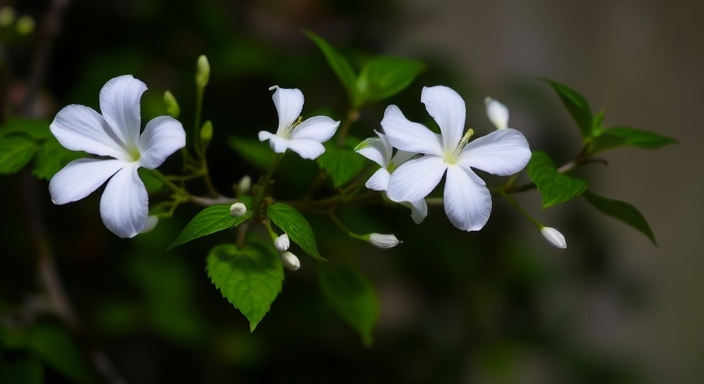When you think of remedies for common ailments, your mind might wander to over-the-counter medications or perhaps traditional herbal teas. However, nestled in the botanical world is a plant that has been revered for its enchanting beauty and remarkable medicinal properties: the night flowering jasmine, known scientifically as Cestrum nocturnum . This captivating plant not only fills the night air with its sweet fragrance but is also celebrated in various cultures for its potential health benefits, particularly in managing fever.

The Allure of Night Flowering Jasmine:
The night flowering jasmine is a perennial shrub native to the tropical and subtropical regions of the Americas. It thrives in warm climates and can be found in gardens and natural landscapes, often climbing toward the stars. Its small, tubular flowers bloom at night, releasing a heady fragrance that attracts nocturnal pollinators. The plant’s glossy green leaves and delicate white-yellow flowers make it a favorite among gardeners looking to create a sensory experience in their outdoor spaces.
But beyond its aesthetic appeal, night flowering jasmine holds an important place in traditional medicine. Various cultures have recognized its potential therapeutic properties, often using it to alleviate a range of ailments.
Night Flowering Jasmine and Fever: Traditional Uses:
Fever is a common physiological response to infection or illness, characterized by an elevation in body temperature. It can be a result of a myriad of factors, from viral infections to inflammatory responses. While modern medicine provides effective treatments, many people turn to traditional remedies for relief, and night flowering jasmine is one of those herbs that have shown promise.
In traditional Ayurvedic medicine, night flowering jasmine is believed to have antipyretic properties, meaning it may help reduce fever. The leaves and flowers are often made into infusions or poultices, which are then administered to patients suffering from high temperatures. Some herbalists recommend preparing a tea using the leaves, which can promote sweating and help to cool the body, potentially aiding in the body’s natural healing processes.
Furthermore, the plant is known for its calming effects, which can be particularly beneficial for individuals suffering from fever. A fever can often lead to discomfort, agitation, and sleep disturbances. The soothing fragrance and potential sedative properties of night flowering jasmine may assist in promoting relaxation, allowing the body to recuperate more effectively.
How to Use Night Flowering Jasmine:
If you’re considering incorporating night flowering jasmine into your health routine, there are various ways to use this extraordinary plant:
1. Infusion
Preparation:
- Use fresh or dried leaves (about 1 tablespoon of dried leaves or 2 tablespoons of fresh leaves).
- Boil water and allow it to cool slightly before pouring it over the leaves.
- Steep for 10–15 minutes.
- Strain the leaves from the liquid and enjoy the tea.
Benefits: The warm liquid can help hydrate and soothe the throat, while the herbal compounds may support fever relief.
2. Poultice
Preparation:
- Crush fresh leaves to release their juices (you can use a mortar and pestle or a rolling pin).
- Apply the crushed leaves to a clean cloth and then place it on the forehead or wrists.
Benefits: This method provides a localized cooling effect and can be particularly comforting for someone with a high fever, helping to draw heat away from the body.
3. Essential Oil
Usage:
- If using a diffuser, add a few drops of night flowering jasmine essential oil and let it disperse in the room.
- For topical application, dilute 1-2 drops of the essential oil in a carrier oil (like coconut or jojoba oil) before applying it to the skin.
Benefits: The calming aroma may help reduce anxiety and promote relaxation, making it easier to sleep, especially during illness.
4. Tincture
Preparation:
- If making your own tincture, you’ll typically use a high-proof alcohol to extract the beneficial components from the leaves.
- Use a jar to combine plant material with alcohol (fill the jar about halfway with leaves and top it off with alcohol) and let it steep for several weeks in a dark place, shaking it occasionally.
Dosage: It’s crucial to consult a qualified herbalist or healthcare provider to determine appropriate dosages, especially given the potency of tinctures.
Benefits: Tinctures can provide a concentrated dose of herbal compounds, offering more powerful effects than teas or poultices.
Caution and Considerations:
While night flowering jasmine is celebrated for its medicinal properties, it’s important to approach its use with caution. Pregnant or breastfeeding women should avoid using it without consulting a healthcare provider. Additionally, individuals with allergies to plants in the nightshade family may experience adverse reactions.
Always consult with a healthcare professional when considering herbal remedies, especially if you are currently prescribed medications or treating serious health conditions.
Conclusion:
The night flowering jasmine stands as a testament to the wonders of nature, offering both visual beauty and potential health benefits. While more research is needed to fully understand its effects on fever and overall health, it remains a cherished herb in many cultures around the world. As we look toward holistic and natural pathways to health, the night flowering jasmine may just be the fragrant ally we need in our wellness journey. As with all herbal remedies, ensure to approach its use mindfully and thoughtfully, always prioritizing your health and safety.
thank you for reading this article
Discover more from fuel for life
Subscribe to get the latest posts sent to your email.
